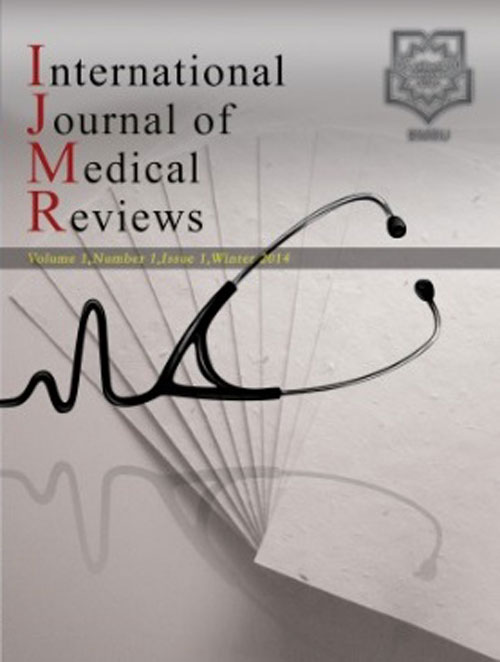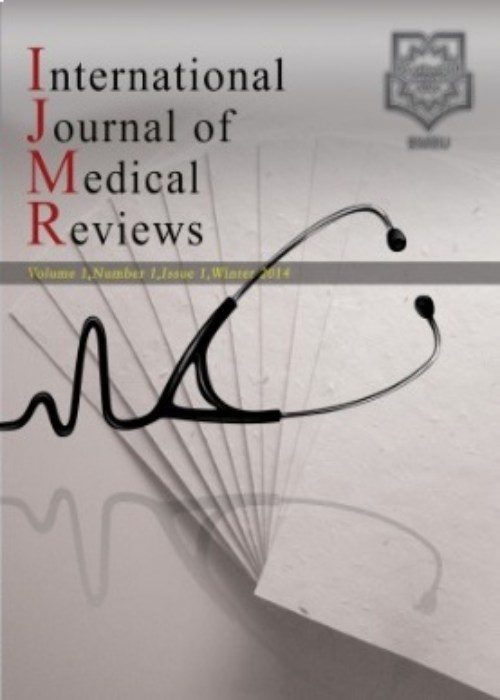فهرست مطالب

International Journal of Medical Reviews
Volume:3 Issue: 3, Summer 2016
- تاریخ انتشار: 1395/07/17
- تعداد عناوین: 7
-
Pages 457-468Searching the term vitamin D in a database like PubMed results in about 80 000 articles and shows that the number of submitted articles has raised exponentially in recent years. This number about equals the results for hepatitis B, indicating that new roles for vitamin D in the body have been proven in recent years. Vitamin D is a vital substance that plays a lot of important roles in the body, e.g., it reduces mortality risk in the elderly,1 it displays anticancer properties,2 and has a regulatory role in calcium and bone homeostasis. Vitamin D is also an important immune modulator that plays important roles in infectious diseases such as viral hepatitis...
-
Pages 469-471The ingestion of various foreign bodies that causes respiratory trouble and dysphagia is a worldwide problem among all age groups. Securing the airway by tracheostomy is imperative, and direct laryngoscopy gives prompt analysis. The significance of the contributory history and its perception is accentuated in the findings and early treatment. Foreign bodies in the ear, nose, and throat are at times found in family pharmaceutical, ordinarily in children. The most widely recognized foreign bodies are bits of food, plastic toys, and little family things. Determination is frequently postponed in light of the fact that the causative occasion is generally in secret, the manifestations are nonspecific, and patients are frequently misdiagnosed at first. Most remote bodies in the ear and nose can be removed by a talented doctor in the workplace with negligible danger of inconveniences. Normal evacuation techniques include the utilization of forceps, a water system, or a suction catheter. Foreign bodies in the pharyngeus or trachea are medical crises requiring surgery. Radiography is regularly prescribed. Adaptable or inflexible endoscopy as a rule is required to affirm the diagnosis and to expel the foreign body. Doctors need to employ a large amount of doubt for foreign bodies in children with unexplained upper airway side effects. It is essential to get it the life systems and the signs for subspecialist referral. Sufficient proof to make solid proposals for particular expulsion strategies is lacking.Keywords: Tooth, Fish Bone, Foreign Bodies, Emergency, Airway, Stridor, Obstruction, Tracheostomy
-
Pages 472-475Global experiences show that it is practically and economically impossible to aggregate all services in the form of public health insurance with the increasing diversity in patient care services, and any institution which receives per capita payments, is able to provide all services. Considering the growing diagnostic costs in our country, it is not practically feasible to use more up-to-date and expensive medical technology and the introduction of new therapies that cover the treatment costs in the form of basic health and state-owned insurances; as a result of the progress of this trend, more and more people will be deprived of appropriate health services on a daily basis; therefore supplemental insurances are used in many countries to cover some services.Keywords: Insurance, Health, Supplementary Medical Insurance, Health Services
-
Pages 476-481There have been changes in the perceptions of health and healthcare. The key elements steering this change are the identification of social ramifications of disease and the agreement that healthcare strategies are directed at increasing the length and standard of life. There is a lack of consensus on defining the expression quality of Life (QoL). Some believe that QoL is synonymous with health, while others suggest that it is a comprehensive domain inclusive of larger domains relating to human experience. Oral health related quality of life (OHRQoL) is a comparatively recent phenomenon which has emerged over the last couple of decades. A potential reason for the recent emergence of OHRQoL could be the rather limited realization of the ramifications of deteriorated oral health on QoL. This paper attempts to identify various oral conditions and sociodemographics that affect the QoL of people. Since OHRQoL is a subjective measure, it is not exclusively dictated by oral health status. The concept of hierarchy of needs was highlighted to explain the poor utilization of oral health services, and it was concluded that the promotion of health and the creation of a complimentary socioeconomic environment are the only ways to improve peoples QoL.Keywords: Oral Disease Burden, Quality of Life, Socioeconomic Inequalities, Hierarchy of Needs
-
Pages 482-488Branch retinal vein occlusion (BRVO) is the next most common retinal vascular disorder following diabetic retinopathy, and macular edema is the most frequent cause of visual impairment in patients with BRVO. For many years, grid laser photocoagulation was the standard of care for the treatment of BRVO-associated macular edema. Grid laser photocoagulation was used for patients with macular edema secondary to BRVO longer than 3 months and visual acuity less than 20/40. Currently increasing data supports the effect of anti-vascular endothelial growth factors in the treatment of BRVO-associated macular edema. Recent studies have shown that intravitreal bevacizumab injection is a safe and effective modality for the treatment of BRVO-associated macular edema; however, the recurrence of macular edema is common following an intravitreal bevacizumab injection. Other anti-vascular endothelial growth factor (VEGF) agents such as ranibizumab, pegaptanib, and aflibercept are effective options. Combining anti-VEGFS with grid laser may be effective in refractory cases and also may prolong the interval between intravitreal injections. Switching to a different anti-VEGF or dexamethasone implant may be effective in the treatment of refractory cases; however, the efficacy of an intravitreal dexamethasone implant may diminish after a few months, and elevated intraocular pressure and cataract formation may occur.Keywords: Branch Retinal Vein Occlusion, Macular Edema, Anti-VEGF, Intravitreal Injection
-
Pages 489-493IntroductionGraves disease is an autoimmune disease that is associated with thyroid gland involvement and is most common in young women. During pregnancy, it is the main cause of hyperthyroidism, as the thyroid gland volume and thyroid hormone synthesis increase. Changes in the immune system during pregnancy can affect the onset of disease. During pregnancy, the pathological cause of Graves disease is immune deficiency. This study investigated changes in the thyroid gland occurring during pregnancy, the causes of Graves disease during pregnancy, and its diagnosis and treatment.MethodsA search of Google scholar, Ovid, and MEDLINE was conducted with the search terms Graves disease, pregnancy, and treatment.ResultsA total of 65 titles were initially identified with the search strategy described. Twenty-five publications were excluded. Out of the remaining articles, 19 articles were used in terms of content. Treatment for Graves disease is determined according to the patients condition, the priority of the patient, and the resources available. Treatments include oral anti-thyroid drugs (ATDs), radioactive iodine, and surgical procedures. Among the oral prophylactic drugs, Propylthiouracil is used during lactation. Radioactive iodine is not used during pregnancy or lactation. Thyroidectomy is better to be used in the third trimester of pregnancy.ConclusionThe treatment of Graves disease is very important; if not treated, this disease causes many complications with the fetus. After delivery, the mother and the baby should be monitored for thyroid problems. Pre- and postpartum planning and the effective management of Graves disease in women of childbearing age are necessary to prevent the pathogenesis of Graves disease during pregnancy.Keywords: Grave's Disease, Pregnancy, Therapeutics
-
Page 494The prevalence of primary hyperhidrosis (PH) is reported to be as high as 6.1% by different studies. It is a rather prevalent disease in eastern Asia and the Middle East. Treatment of PH is either medical or surgical, but each of these has its own problems. Diverse medical treatments include hygiene protocols (such as absorbent powders, cotton gloves and socks, etc), topical agents such as aluminum salts, systemic anticholinergics, antidepressants, antianxiety agents, iontophoresis, Botox injections, microwave thermolysis, and topical laser. However, these therapeutic options are not sufficiently effective. Moreover, their effects are transient, requiring the repetition of treatment, and accompanied by bothersome side effects that leave patients dissatisfied; ultimately, many patients abandon treatment...


